Taking your first steps into a new social media platform allows your government agency to reach different audiences and experiment with new content formats.
But it also presents challenges — not least how to grow your following from scratch. As with anything in the world of social media for government, it’s essential to have a clear plan.
To help you out, Mike Mueller — Digital Media Specialist at the US Department of Energy’s Office of Nuclear Energy — shared the best practices he learned from launching the agency’s Facebook, Twitter, and LinkedIn accounts at our Social Media Strategies Summit for Government.
Mike and his team grew those accounts from zero to almost 150,000 followers in just five years.

This growth has helped the agency deliver a 610% increase in website page views.
Read a step-by-step guide covering everything from the pre-launch phase to promoting and optimizing your content.
1. Develop Your Social Media Strategy
Before blindly leaping into a new social media platform, take the time to craft a strategy that helps you understand:
- Your social media goal
- How you’re going to measure performance
- Which audience(s) you’re trying to reach
That way, you can be sure that the results you drive will contribute to your agency’s overarching objectives.
Mike explains how this looked for the Office of Nuclear Energy:
- Goal-setting: “It was really raising awareness about the benefits of nuclear energy. We felt that there was a big knowledge gap in that area, and we really wanted to focus on getting the word out about the benefits of the nation’s largest source of clean power, which is currently nuclear power.”
- Performance measurement: “We really wanted to look at engagement as our top priority in terms of reactions, shares, who are the actual people interacting with our social media content. Comments and shares were prioritized more than passive reactions or likes.”
- Defining audience: “We’re looking at Gen Z and Millennial types, aged 30 – 45 or even younger. They’re like-minded in terms of climate policy or clean energy, in addition to other tiers of audiences that we’re looking at — industry and trade organizations, news reporters, news outlets, congressional stakeholders.”
Once you’ve figured out all these top-level details, it should be (relatively) simple to identify the social platforms that best fit your social goals and audience. And if you’re not sure, check out our complete guide to building a social media strategy, where we discuss the strengths and audiences of five major social platforms.
Next, it’s time to get a little more granular by considering the types of content you’ll be able to create, the assets you already have available, the tone of voice you’ll adopt, and what your competitors are doing.
Your analytics platform will be your best friend at this stage. For instance, Mike used Google Analytics to look at the content types that performed strongly across the Department of Energy website.
He discovered that the Office of Energy Efficiency & Renewable Energy was driving traffic with evergreen content. “So I decided to build from the ground up a knowledge base of nuclear energy based on some of the topics that were performing well on our website,” Mike shares.
Having done all the research, Mike and his team landed on three platforms: Facebook, LinkedIn, and Twitter.
Rather than launching all three simultaneously, they planned a phased rollout, starting with Facebook. “I would recommend honing your craft on one platform and then slowly building up your following and fan bases before launching another channel. Really devote the time and the resources that you need to make that successful.”
2. Figure Out Your Approval Process
You know the sort of content you’re going to post and where you’ll post it. But how does it work in practice?
Regarding the government on social media, teams often have to do more with less. You might only have one or two people to create content, run accounts, design graphics, edit videos, and more. To make things even more challenging, many agencies face a lot of back-and-forth around reviewing content. So your approval process must be crystal clear.
Currently, the Office of Nuclear Energy’s process is geared toward the basics of creating content within Mike’s team.
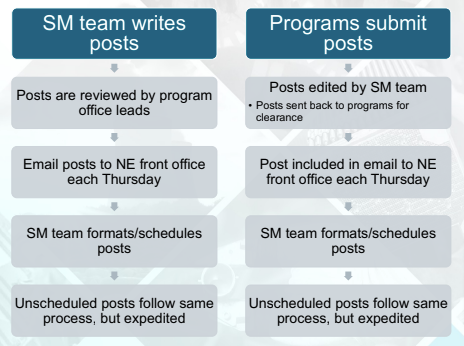
However, Mike hopes to get other stakeholders more involved in the process. “We’re looking to give a little bit more ownership to the programs, invest them in the process of how to submit ideas or social media posts.”
3. Choose Your Social Media Management Tools
Spending less time scheduling social media posts and gathering data is in your best interests when resources are tight.
That’s why social media management tools are worth their weight in gold.
For instance, the Office of Nuclear Energy uses Sprout Social for analytics and pulling data from social platforms.
Of course, those aren’t the only options. Mike recommends a bunch of other social media tools, including:
- Hootsuite
- TweetDeck
- MavSocial
- Buffer
- Facebook Creator Studio
- Twitter Studio
For more insights, check out our guide to the best tools for small social media teams.
4. Plan Your Page Promotion Strategy
Once you’ve launched your new social media account, you need to start spreading the word.
Fortunately, most government agencies have a wealth of promotional strategies. For instance, the Office of Nuclear Energy was able to lean on multiple departments with robust social followings within the Department of Energy.
“Identifying industry stakeholders, community stakeholders, and people within the Department of Energy to help promote our page and our channel once it went live really gave us an initial push,” Mike explains. “Not just from the industry and educational community of our stakeholders, but also people who follow all the different happenings at the Department of Energy and our National Labs, which gave us that diversity we were looking for in terms of followers.”
5. Optimize Content to Meet Audience Needs
One of the most effective ways to build a following is to optimize your content around the interests and needs of your audience.
“We want to be educational. We want to be fun. We want to be engaging, and we want to have an open conversation,” says Mike. “And the best way of doing that is really optimizing your content to make sure that the stuff that you’re putting out will reach as many people as possible.”
Start with the basics: optimizing your profile.
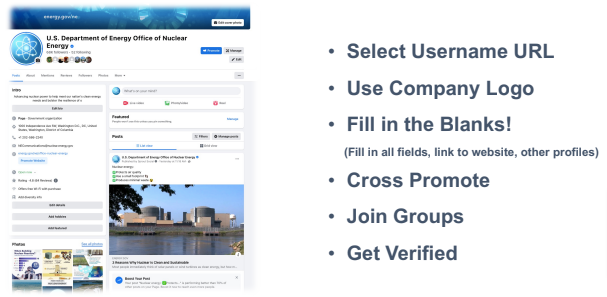
As you can see, there are various steps to this process, but it’s mostly a case of filling in the blanks.
However, Mike has some specific guidance around usernames: try to keep them consistent across all your platforms. The Office of Nuclear Energy’s Twitter username — @GovNuclear — is different from its LinkedIn and Facebook names, but Mike hopes to address this soon.
But optimization is about more than just filling out your social profiles correctly.
Another key issue is image size. Each platform has its recommended image dimensions; taking the time to size images correctly makes a huge difference in engagement.
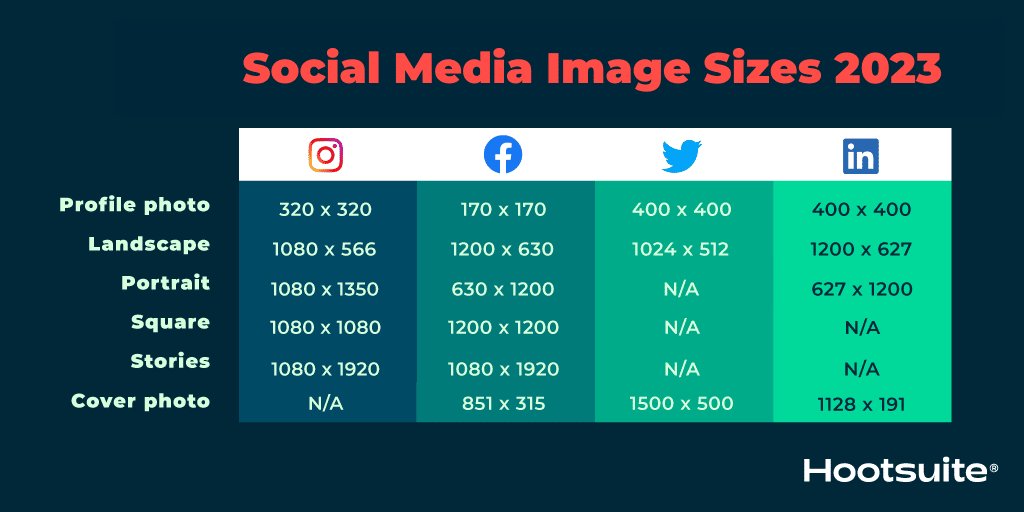
For Facebook, Mike’s team favors either square or vertical photos, whereas they use mostly landscape images for Twitter and vertical for LinkedIn. “Assuming most people are looking at these on their phones, the vertical just stands out and pops a little bit more and has been more responsive in terms of engagement,” he explains.
The same goes for video. Traditionally, the Office of Nuclear Energy stuck to 1080 x 1080 pixels across all platforms, but it has increasingly started to experiment with vertical formats — just like you’d see on TikTok or Instagram Reels.
There’s always that ONE guy in the office. #dadjokes pic.twitter.com/RY3mviyJVn
— Office of Nuclear Energy (@GovNuclear) January 29, 2023
Mike has one more tip on video optimization: 92% of viewers watch videos on mobile with the sound turned off, so be sure to add captions. That means either:
- Burning captions into the videos
- Uploading an SRT file so the captions will be generated as people are watching
6. Repurpose Your Content in Multiple Formats
If you have a small social media team, you might lack the bandwidth to create brand-new content constantly. Moreover, different types of content resonate with different people. Some of us prefer text; others favor graphics or video.
For both reasons, it makes sense to repurpose your content into several different formats.
This approach has helped the Office of Nuclear Energy boost its content creation efforts and better understand the best content types on each platform.
For instance, the agency wrote an evergreen article entitled: “5 Fast Facts About Nuclear Energy.” Mike’s team also turned it into an infographic and a video.
Not only does this give the office more content to share, but it also opens up various tactics for social media promotion.
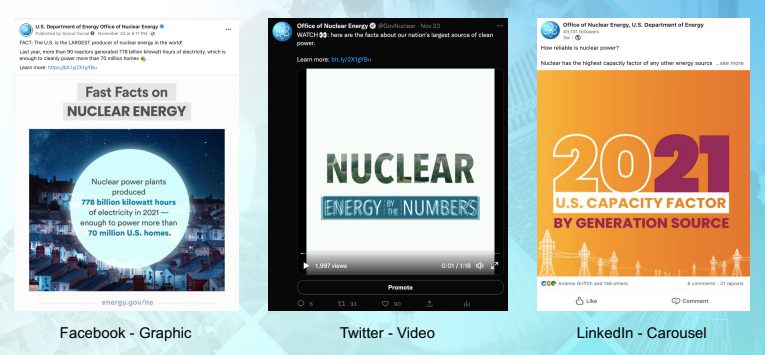
“We can use those all in different ways on social media,” Mike explains. “Sometimes we’ll copy and paste the whole blog in a Facebook post and use one of the images, or possibly the video. Other times we may cut up an individual fact and highlight that fact on Twitter.”
Conclusion
Inevitably, the more resources you have, the quicker and easier it will be to build an engaged following on a brand-new social media account.
But that doesn’t mean small, time-retrained social teams can’t deliver actual results.
Whether you’re repurposing existing content assets, streamlining your approval process, or optimizing content to better meet the needs and interests of your audience, it’s all about working smarter, not harder.
Featured image by Freepik.
Want to learn more about how government marketing leaders use social media to grow their brands? Register for our upcoming government social media conference!
Here are some similar articles you might enjoy:
- How Government Agencies Can Consistently Create Great Content
- 10 Government Agencies Killing it on TikTok
- 10 Ways Government Agencies Can Increase Their Engagement on Social Media



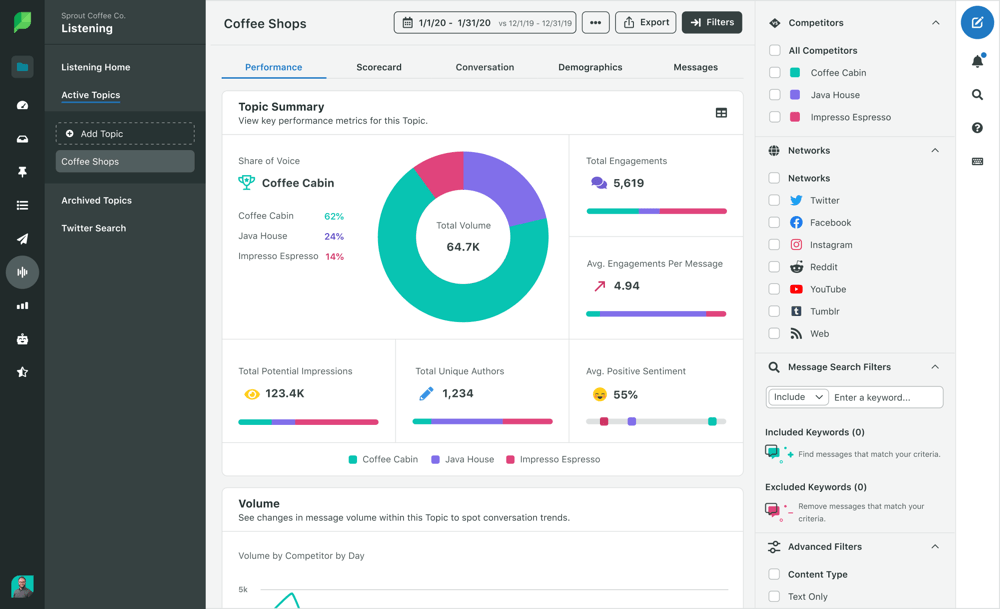 Image source
Image source






